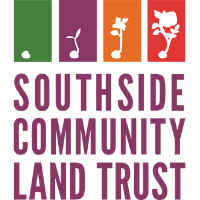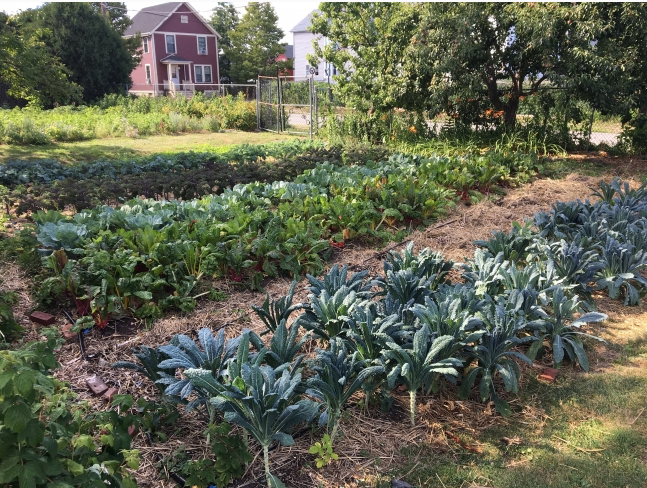It’s the height of the season at City Farm, a ¾-acre oasis on the south side of Providence where tomatoes are ripening, greens are flourishing and late-summer plants are beginning to grow. As part of Southside Community Land Trust, the expanse is an urban teaching farm that also provides an income stream for the nonprofit, which helps nurture food production in the capitol city.
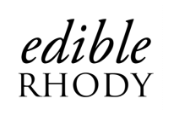 City Farm prides itself on its rich compost, which takes up to a year to develop before being used on the farm. Nick Ogrinc, City Farm intern, describes how their soil differs from that of other farms: “At some farms there isn’t as much thought put into how the compost pile is built. Here, Rich [Pederson, City Farm steward] has a very specific system. It’s thoughtful, just like everything else we do here at City Farm. There’s a lot of care put into all the practices.”
City Farm prides itself on its rich compost, which takes up to a year to develop before being used on the farm. Nick Ogrinc, City Farm intern, describes how their soil differs from that of other farms: “At some farms there isn’t as much thought put into how the compost pile is built. Here, Rich [Pederson, City Farm steward] has a very specific system. It’s thoughtful, just like everything else we do here at City Farm. There’s a lot of care put into all the practices.”
Over the years, City Farm has built relationships with various people and organizations in or near Providence who help provide them with leftover materials to build up their compost. Here’s a look at some of the ways they partner with community members to make a rich humus in order to grow City Farm food:
The Force Is With Them
On Monday mornings the City Farm staff travels to Roger Williams Park, where they pick up a truckload of horse manure and bedding, including straw and wood shavings, from the Providence Police Department Mounted Command Unit—or more specifically, Perk, Adonis, Charlie, Arlen and Goliath. This important ingredient is used to add carbon to the compost.
Trading Flowers for Coffee Grounds
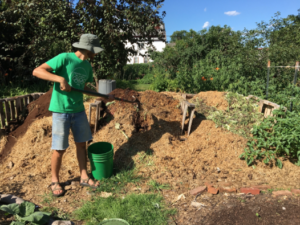
Nick Ogrinc, City Farm Intern, adding food scraps to the compost piles at the entrance of the farm.
Twice a week the City Farm staff travels a few blocks towards Westminster Street to White Electric Coffee. They enter the coffee shop with handfuls of bouquets for the café tables. After exchanging the flowers from last week’s delivery, the staff goes around to the back to pick up used coffee grounds. Coffee grounds provide much-needed nitrogen to the compost.
Leftovers Become Nutrients
During the week, New Harvest Coffee Roasters delivers chaff, which is a byproduct of the roasting operation that would otherwise go to waste. New Harvest also gives City Farm burlap bags left over from coffee bean shipping, which are used on the farm to transport produce, mulch the garden beds and gather materials.
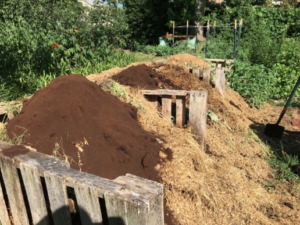
Bins of coffee grounds and chaff from New Harvest Coffee Roasters used in the compost.
Preparing for Winter
Come October, when everything green has died and nighttime frosts begin, the City Farm staff travel to beaches around Rhode Island hunting for seaweed to cover the beds. The seaweed is used to weigh down the straw and provide nutrients to the soil during the winter. The facilities manager at Brown University brings shredded leaves that are also used to cover the beds, and then turned back into the soil to begin the next growing season in the spring.
Community Cooperation
Ogrinc says, “There’s something really beautiful about reusing materials from the community and using them to build the soil. The compost is so magical because you have trash and you turn it into something that you can grow food with.” By utilizing components that would otherwise go to waste, City Farm has developed the perfect recipe for nutrient-rich compost, a critical ingredient in the success of their growing operation. Without City Farm, community businesses and organizations would have to find other ways to dispose of their leftover material, like resorting to tossing it in the landfill.
Matt Lovecchio, assistant farm steward at City Farm, says “The convenience and efficiency of being in a densely populated area is that we’re able to tap into a lot of the materials in our local environment. We add a lot of organic matter to the compost and all that organic matter is coming from this area. A lot of that energy is staying in the ecosystem that we’ve created here, and we’re decreasing the amount of mileage used to get the inputs for our soil and for our produce.”
City Farm uses what the surrounding area has to offer to make something sustainable, useful and resilient. Densely packed rows of thriving vegetables, towering fruit trees and flourishing herbs fill every inch of the biodiverse farm, all thanks to the fertile City Farm compost.
Original article: http://ediblerhody.ediblecommunities.com/food-thought/city-farm-how-urban-farm-s-compost-reflects-its-commitment-community
